

Abstract
Positional and concretistic (calculating) chess are opposites that stand in a compensatory relationship. The positional player will make different moves than the calculating player. I contend that a deep positional move cannot be reached by concrete calculation alone. Still, in the majority of positions the positional and the concretistic player would choose the same move. As a matter of fact, positional chess is an amazing capacity as a player with weak calculating ability is sometimes capable of playing good chess. This never occurred during the romantic era. There are also two “visionary” types, namely the tactician and the strategist.
Chessplayer typology
Traditionally, a chessplayer’s style is designated either as positional or tactical. However, these concepts aren’t really opposites. A positional player will make tactical considerations while judging positions. For instance, one frequently talks about dynamic compensation for pawn. This means that the player calculates that his tactical vision will help to compensate the material deficit. It is typical for positional players to make these “tactical” decisions to sacrifice pawns. As a matter of fact, it is the concept of strategy which is the opposite of tactics.
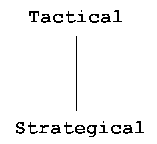
Positional qualities don’t stand in opposition to tactical. Hence a positional player can be a strong tactician. An example of this is the pronounced positional player Tigran Petrosian. Prior to the World Championship match in 1966, Spassky got the advice to stir up tactical complications since Petrosian, because of his positional style, was regarded a weak tactician. Spassky later came to regret that he followed this advice. He even said afterwards that tactics was Petrosian’s main strength. The trouble stirred up by his opponents suited Petrosian fine since he, by using his well-developed tactical vision, could foresee and refute his opponent’s ideas. He had no significant problem with Tal either, during the latter’s harryings in the sixties.
Since positional judgment cannot be viewed as diametrically opposed to tactics, what is the opposite standpoint of positional understanding, then? In today’s computer chess era we have once more opened our eyes to concretistic (pragmatic) chess. Whereas computers are bad at formulating logical plans, they can compensate their weak positional understanding by means of massive calculation. On the other hand, logical planning is very central to the human positional player. The conclusion is that concretistic chess must be regarded the complementary opposite of positional chess. Chessplayers are aware of the fact that they can trust their positional assessment despite the relative complexity of the position. However, positions exist where concretistic chess treads in the foreground. An example of this are knight endings, which often exclusively require calculation.
However, more often than not, positions occur that are balanced to the extent that it depends on the disposition of the player whether concretism (pragmatism) or positional judgment is principally used. The upshot is that the two different types will, in the same position, often arrive at different decisions — and both may be right! Hence we may conclude that concretism and positional perception constitute a pair of opposites.
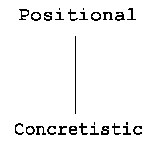
The realistic type
The latter pair of opposites portrays the realistic type since this type strives after the objective truth in every game. The predominant concern of the positional player is to find the correct plan; the plan that is in accordance with the demands of the position. He disregards the greater part of the concrete variation tree in his search for the correct plan. Furthermore, he principally uses his assessment (not calculation) to cut off sub-trees from the variation tree.
The concretistic player, on the other hand, aims to solve the problems of the position by finding the correct concrete variations. If one encounters a concretistic player one is often struck by his clear-sightedness and technical efficiency. That’s why a concretist such as Kasparov is called “the monster with a thousand eyes” — he sees every variation. The concretist takes a firm grip on the immediate problems of the position, and he seldom blunders. He could also be called the technical type. These two types have the character of truth-seekers. In science there is a corresponding division into theoretical physicists and practical lab physicists.
The visionary type
The other pair of opposites must be regarded as the visionary type since they foremostly try to conjure up tactical or strategical motives, respectively. They are less interested in the correctness or the inherent truths of the position. This doesn’t mean that tactical or strategical elements are irrational, but merely that players who prefer these qualities before correctness and truth must be considered visionary. The visionary notion should not be regarded a derogatory concept. There is an artistic quality to the works of this type.
I also want to clarify the very concept of tactics. To me it signifies tactical vision, i.e. the creative function whereby tactical ideas are formed. So by tactics I don’t mean variation calculus. A tactician strives after solving the problems by tactical means. This is, as in all other instances, dependent on variation calculus. But the tactician doesn’t put the variation calculus in the foreground. He invests a great amount of energy trying to create tactical motives, and this is something quite different from variation calculus. Since concretistic calculus is merely an auxiliary function with the tactical type, he will make a few errors. But this doesn’t bother him much, as long as he wins by tactical creativity.
Discussion
By combining the realistic and visionary pairs of opposites we may construct the following cross of opposites:
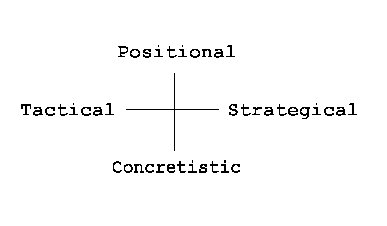
By looking at this picture it is easier to understand why a positional player is expected to be strong both tactically and strategically. With the positional player, positional comprehension is primary whereas strategical and tactical creativity are auxiliary functions. The latter functions can harmonize with the positional. However, looking at the above cross, it is obvious that the concretistic function stands in opposition to the positional. Two opposing functions cannot be simultaneously utilized. A player that is disposed toward abstract positional thought will not only devote less time to concrete calculus, but he will also remain relatively blind to the more immediate problems of the position, e.g. that his queen is threatened. Consequently, with the positional type concretism remains relatively repressed; it becomes the inferior function.
Also here the positional player Tigran Petrosian is a good example. When he was asked the obligatory question of how many moves he counts, he answered half-jokingly: –One! Petrosian at an early stage in his career realized that he was rather weak in his concretistic function. Therefore he devoted much energy to strengthen his calculative ability. He trained by reading chess games without using a board and by visualizing the position until the next diagram was reached. It is worthy of imitation to in this way exercise one’s inferior function. Obviously, Petrosian as World Champion was not bad at concrete calculus. Nevertheless, it remained his weakest function. He didn’t need it that much since his positional understanding was so well developed. His realistic attitude is apparent from his outspoken striving after logic in chess. He was taken aback by Viktor Korchnoi’s balancing on the edge of disaster.
Style diagrams
Since positional assessment must be regarded Petrosian’s primary function, his style diagram should be depicted with the positional function on top. I have encircled the primary function and what I call the secondary function — in Petrosian’s case the strategical. The secondary function is the one auxiliary function which the player prefers to use. It can also suitably be called the help function. As is well-known, Petrosian preferred to solve the problems on the board in a strategical way rather than by tactical means. He was never in a hurry to arrive at a conclusion. Petrosian’s style diagram:

The auxiliary functions could be more balanced so that it becomes difficult to decide which one is secondary. I believe Karpov belongs to the same type as Petrosian. His secondary function is also the strategical, but since he is somewhat more balanced his tactical function stands out more clearly. In other words, his style is not as slow as Petrosian’s.
An excellent example of the utilization of the secondary function is the way in which Michail Tal during the years around 1960 shifted primary function. He had realized that the successful positional paradigm had made the chess world blind to the power of the visionary function. He went over from having been a positional player to become a devoted tactician. As his primary function he now utilized his earlier secondary function, namely the tactical. This meant that he devoted much energy during the games to conjure up tactical motives by means of tactical creative vision. He did not bother whether the variations were really credible or not. After this period Tal went back to his former primary function — the positional. It is not hard to realize to what type Kasparov belongs. His style diagram looks like follows. Kasparov’s style diagram:
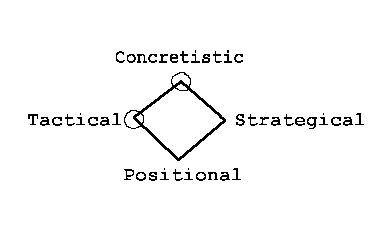
True to the realistic type, Kasparov has an extremely strong desire to arrive at the truth in every position by means of concrete calculus. This attitude is evident from his concept of ’Advanced Chess’ whereby computers are utilized to further enhance the calculative function. Yet, it is likely that, in his case, the concretistic function will become overly developed. It does not bring about the deepening of the game that was intended. On the other hand, the positional player may improve his chess by Advanced Chess, because the inferior function is thereby strengthened.
The calculative player is, because of his relatively inferior positional function, dependent on preparations, to the effect that the positional problem-complex, i.e. the planning, is to a great extent resolved already from the beginning. This is very obvious in Kasparov’s case. There is with this type a tremendous passion for concrete variations. Their tactical vision and their strategical inventiveness are seldom lacking. However, they lack the capacity of the positional type to judge the plausibility of the ideas. They don’t have the same depth of understanding, and the auxiliary functions are not as effectively utilized as with the positional type. Creating logical plans is their weakest side. The calculations use up a lot of energy. Karpov, on the other hand, is capable of solving the abstract problems at the board.
In Kasparov’s case his dilemma became obvious in the match against Deep Blue. One would expect a computer to be a pronounced concretistic player. One must, however, keep in mind that it lacks a well-developed tactical or strategical vision. Consequently, it must try to compensate also the lack of these with massive calculation. So a computer cannot really be judged a concretistic player according to human measures. Rather, the computer is calculative.
Kasparov, however, wanted to fight the computer using a suitable antidote, namely a pronounced positional style of play. He indeed tried to play like Petrosian against the computer. But since the positional function is his weakest, the attempt failed. Although the concept was fortunate in certain games, many chess players argue that he would have been better off playing in his normal style, even if it might have suited the computer better. I believe that Karpov or Petrosian (if he had lived) would have been capable of defeating the computer.
As examples of visionary types I would like to mention Spassky and Botvinnik, respectively. The visionary type does not seem to be as bound by the laws of the game as the realistic type. Spassky could shift between positional play and concretistic. Accordingly, this type is often viewed as a pragmatist. But the guiding principle for Spassky was his tactical vision, which probably outshines any other tactical prodigy that the world has ever seen. Spassky always tried to use his magical wand. It wasn’t particularly vital to him whether or not it was positionally motivated or whether there existed concrete variations in the background that could interfere with his tactical vision. He was even prepared to play unsound openings in battle against the world elite. Spassky definitely deserves the denomination of tactician. The chameleon-like character is easily understandable if one ponders the diagram below. The positional and concretistic functions are both auxiliary. The fact that the strategical function is inferior explains Spassky’s impatient nature. Spassky’s style diagram:

The strategical player is the odd bird among the flock of chessplayers. Their greatest weakness is the tactical vision since it constitutes the inferior function. Botvinnik also expressly said that his greatest weakness was his tactical vision. He was often rather unsuspecting and naive, which became obvious in the first match against Tal. He took the corresponding measures as Petrosian did, and worked to improve his inferior function. The strategists seem to have a fighting spirit and persistence that is admirable. To play against Botvinnik was experienced as playing against a steamroller. Below is his style diagram. I haven’t studied him thoroughly so I’m not quite sure whether to place the concretistic or the positional function as secondary. But I have the impression of abstract judgment before concrete calculation, so I encircled the positional function. Botvinnik’s style diagram:
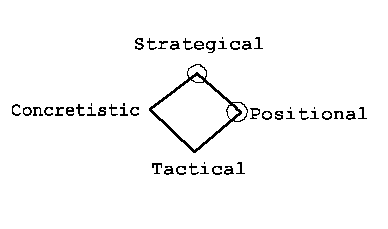
Finally, it could be of interest to construct a cross of opposites with the named players, placing the positional player upmost. This is the result:

Conclusion
The inference of my idea is that we arrive at altogether eight player types, when taking into account primary plus secondary function. At least, this is better than the two types we had before. Thus, it would be possible to construct a star with eight branches and then associate eight top players with the different branches. Done by a cunning person it would be a suitable test for the theory, provided that the evaluation of the players could be substantiated.
It is the player himself who can best determine which type he belongs to. Only the player himself can know how his own thought processes go. But it is often easy to draw conclusions from the games of a player. Of course, the best players have greater scope in all respects compared with the amateur. It’s hard for the weaker player to assess a stronger player’s weaknesses because, relatively speaking, his weak side is strong, too. Botvinnik was a weak tactician compared with his other capacities. This doesn’t mean that he was weak tactically, but only weak compared with his other abilities.
Personally, I only have recourse to my own thought processes, and I clearly recognize my own weak sides. I belong to those who simply must find the right plan hidden in the position. Otherwise I can’t play; so I am definitely a positional player, according to my model. Those who can “conjure up” plans (regardless of their scientific validity) belong to the strategists and the tacticians. However, I often miss out on the concrete aspects in the position, which is due to a lack of concretism. The technical capacity almost disappears sometimes. But if I repress my strongest function (the planning function) when playing blitz, then I am reasonably strong technically.
The “philosopher” must be repressed if one is to be strong technically. Chess is problematic in this sense. There is an ongoing conflict between these different faculties. Comparatively, in archery, only the technical (concretistic) capacity should be operative during contests. However, in chess this is not possible. You cannot play with the backbone only, but conflicting functions must stay active simultaneously. That’s why a positional super-GM can sometimes blunder away a piece in the opening. There are amateur players who would never lose a piece this way, because they are very down-to-earth and technical, i.e. always focused on that which lies near at hand — the thing which immediately suggests itself; the obvious and the natural. On the other hand, this player seldom finds the right plan.
In conclusion, I have suggested a method of determining a player’s style according to a model which employs primary and secondary function. Fischer would be a positional player with tactics as secondary function (or help function). Spassky would have tactics as primary function and the positional as secondary. Botvinnik is a strategist with positional(?) play as secondary function. Kasparov would be primarily concretistic with tactics as secondary. The tacticians and the strategists are the visionary and also the artistic types. The concretists and the positional players belong to the realists, and they are the more scientific types.
© Mats Winther, 1998.